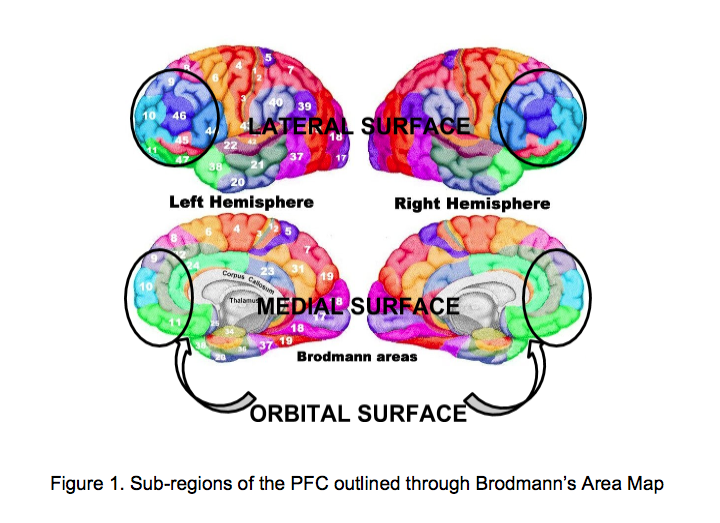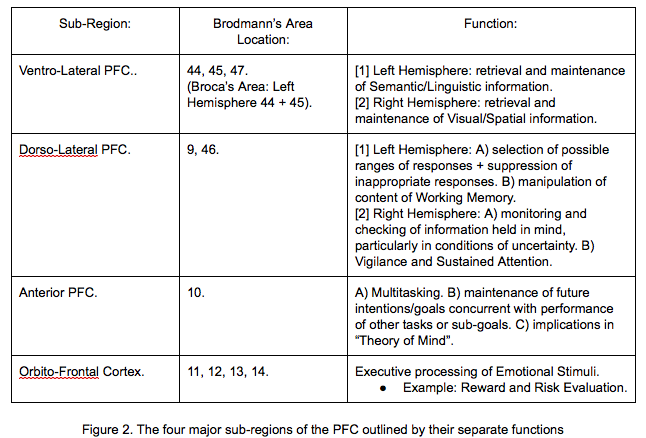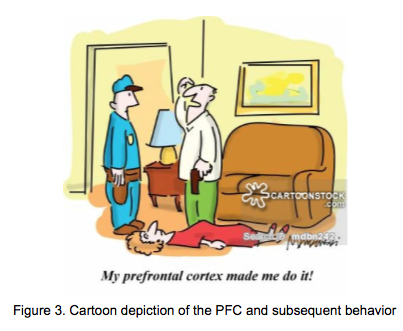Executive function has arguably been one of the most important aspects of neural function that allows humans to develop as a complex species. Where exactly would our species be today without executive function control processes? In order to properly assess this question, one must first gain a better understanding of the underlying mechanisms and functions of the various cortical regions of the Prefrontal Cortex (PFC).
How do we control our impulses?
The PFC is the brain region responsible for eliciting executively controlled responses in the human brain. More specifically, executive functions serve as “control processes” that allow individuals to optimize their performance on a given task [1]. Executive functions require the operation and coordination of severa l more basic cognitive processes in order to bring about the desired action [2]. The theories of the mechanisms behind executive function are very similar to that of working memory because both concepts involve storage components and control processes [3]. Ultimately, it is executive processing that allows us to achieve a variety of mental actions such as decision-making, remembering, planning, and arguably developing our sense of “self” [4].
l more basic cognitive processes in order to bring about the desired action [2]. The theories of the mechanisms behind executive function are very similar to that of working memory because both concepts involve storage components and control processes [3]. Ultimately, it is executive processing that allows us to achieve a variety of mental actions such as decision-making, remembering, planning, and arguably developing our sense of “self” [4].
From an anatomical standpoint, the PFC is the anterior portion of the frontal lobe and more generally can be divided into the following cortical regions; the ventro-lateral PFC, dorso-lateral PFC, anterior PFC, and orbito-frontal cortex[1]
Damage to the PFC: Complications and Implications
It is evident that the prefrontal cortex plays a major role in producing and controlling important behavioral actions. However, what happens to an individual’s behavior when such vital cortical regions are damaged? The PFC is unlike many other brain regions in that oftentimes, people with complications to this area frequently are mistaken for being rude, impulsive, and aloof, instead of having brain damage [5]. They are the ones frequently labeled as perpetually late arrivers, bad planners, and horrible multitaskers…but, is it really their fault?
Many researchers have analyzed the inabilities of patients to share and understand the emotions of others as a major sign of prefrontal cortical brain damage. Kemp et al. (2013) studied a man years after he had experienced a right caudate hemorrhage. He showed right orbito-frontal and prefrontal damage, which was evident when he was significantly impaired in his ability to complete a variety of perspective-taking and recognition tasks of sadness and fear [6]. Fisher et al. (2011) studied a woman after prefrontal and orbito-frontal damage due to trauma and found major deficits across social and executive functions. However, her performance was tested again 7 years later and it was found that her executive functioning and perspective-taking abilities had improved [7]. Although it is clear that there is a major connection between the ability to empathize and prefrontal cortical damage, it is also evident that patients with prefrontal cortical damage may be able to regain their empathizing abilities and executive control, depending on the type of brain damage.
In addition to problems with recognizing social and emotional cues, patients with prefrontal cortical damage often have difficulties with task-setting, problem-solving, and manipulating their working memory [1]. Schacter et al. (1996) studied patient BG, who had experienced damage to the dorso-lateral PFC. Patient BG had difficulties with falsely recognizing “distractors” or “lure” items from previous trials, indicating that patient BG could not accurately monitor the information he was receiving [8]. Additionally, Shallice & Burgess (1991) found that when patients with prefrontal lesions had difficulties with multitasking. More specifically, patients would fail to switch tasks or spend too much time planning without actually executing those plans. Such patients were able to perform tasks in isolation, but could not coordinate between tasks when asked to do so [9].
The Conscience, the Self, and the Psychopath
It is clear that prefrontal cortical damage can impact executive function in the brain. However, recent findings have discovered a relationship between our sense of self and our executive functions. Consciousness is a psychological concept that is important in discussing and understanding one’s sense of self [4]. However, what exactly is our sense of self? Hirstein (2011) argues that the sense of self is developed partly from a summation of executive functions. Hirsten discusses that as philosophers have described “egos” or “the Self” in the past, these concepts may just be the networking and underlying connections of our executive functions within the brain [4].
Consciousness is a tricky concept in that it is not something that we can pinpoint or detect. Similarly to the functions of working memory, we are not necessarily aware of the executive functions themselves, but rather the results that they produce. As neuroscience and neuroimaging are becoming increasingly popular in our society, the psychological self is also becoming increasingly important to analyze from a scientific standpoint. Hirstein argues that it is the executive processes that engender consciousness, which results in our sen
se of self [4].
If our sense of self is really created by the functioning of our brain regions associated with executive function, what does this mean for individuals with Psychopathy? Psychopathy is an antisocial personality disorder that is characterized by impulsive and  inhumane antisocial behavior. Psychopaths often exhibit aggressiveness, failures in planning ahead, “shallow” feelings tow
inhumane antisocial behavior. Psychopaths often exhibit aggressiveness, failures in planning ahead, “shallow” feelings tow
ardsothers, and an inflated sense of self [5]. Ted Bundy, an infamous psychopath, was notorious for ruthlessly murdering multiple innocent women. His inflated sense of self was clearly demonstrated through the narcissistic and remorseless qualities of his personality [10].
Many studies have discovered that there is a strong connection between psychopathy and damage to the prefrontal cortex. Demasio et al. (1990) found that patients who exhibited psychopathic tendencies also had brain damage within the orbital PFC and ventro-medial PFC [11]. Yang et al. (2009) found that psychopaths showed significant cortical grey matter thinning in the right frontal and temporal cortices compared to controls, as well as impaired abilities to recognize negative facial expressions [12].
As demonstrated by Demasio et al. (1990) and Yang et al. (2009), it is evident that there are neural mechanisms behind this inflated sense of self observed in psychopaths. It seems that many of the psychological and philosophical concepts that are associated with our sense of consciousness, character, and self, may infact be the result of the structures and functions of our prefrontal cortical regions. It may be that the rude and overly-impulsive colleague that constantly frustrates us is really just an individual demonstrating irregularities within their prefrontal cortex. However, until our society more thoroughly understands the neural mechanisms of executive functions, our true sense of self will remain an enigma.
References
[1]. Ward, J. (2015). The student’s guide to cognitive neuroscience. New York, NY: Psychology Press.
[2]. Goldman-Rakic., P. S. (1996). The prefrontal landscape: Implications of functional architecture for understanding human mentation and the central executive. Philosophical Transactions of the Royal Society of London B, 351, 1445-1453.
[3]. Baddeley, A. D. (1986). Working memory. Oxford, UK: Oxford University Press.
[4]. Hirstein, W. (2011). The contribution of prefrontal executive processes to creating a sense of self. Mens Sansa Monographs, 9, 150-158. doi: 10.4103/0973-1229.77432.
[5]. Koenigs, M. (2012). The role of prefrontal cortex in psychopathy. Revolutionary Neuroscience, 23, 253-262. doi: 10.1515/revneuro-2012-0036.
[6]. Kemp, J. et al. (2013). Caudate nucleus and social cognition: Neuropsychological and SPECT evidence from a patient with focal caudate lesion. Cortex, 49, 559–571.
[7]. Fisher, T., Shamay-Tsoory, S., Eran, A., & Aharon-Peretz, J. (2011). Characterization of recovery and neuropsychological consequences of orbitofrontal lesion: a case study. Neurocase, 17, 285–293.
[8]. Schacter, D. L., Curran, T., Galluccio, L., Milberg, W. P., & Bates, J. F. (1996). False recognition and the right frontal lobe: A case study. Neuropsychologia, 34(8), 793-808. doi:10.1016/0028-3932(95)00165-4.
[9]. Shallice, T. & Burgess, P. W. (1991). Deficits in strategy application following frontal lobe damage in man. Brain, 114, 727-741.
[10]. Biography.com Editors, Ted Bundy: Biography. Retrieved November 12, 2015, from http://www.biography.com/people/ted-bundy-9231165.
[11]. Damasio, A. R., Tranel, D., & Damasio, H. (1990). Individuals with sociopathic behavior caused by frontal damage fail to respond autonomically to social stimuli. Behavioral Brain Research, 41, 81–94.
[12]. Yang, Y., Raine, A., Colletti, P., Toga, A. W., & Narr, K. L. (2009). Abnormal temporal and prefrontal cortical gray matter thinning in psychopaths. Molecular Psychiatry, 14(6), 561-562. doi: http://dx.doi.org/10.1038/mp.2009.12.




